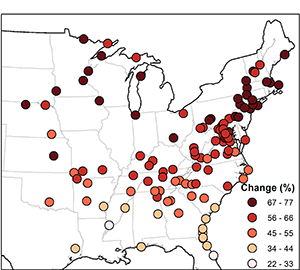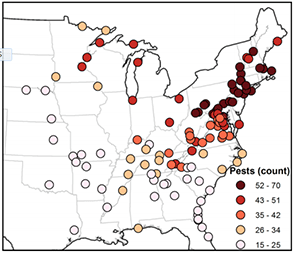Forest Vulnerability Assessment Information Available for 121 Parks
Eastern forests experienced tremendous changes in recent decades and centuries due to direct and indirect human influences. The coming decades will likely bring continued changes due to multiple global change factors including climate change and nonnative species. The National Park Service investigated potential forest change in response to climate, differences in projections of change among climate scenarios (uncertainty), and levels of nonnative biotic stressors (tree pests and invasive plants) at 121 parks in the eastern U.S.

Study Highlights:
Climate change across parks by 2100:
- annual temperature increase of 3-6°C (5.4-10.8°F)
- annual precipitation change of -27% to +75%
- 22-77% of tree species in large change class (>50% decrease or >100% increase)
- 15-70 tree pest species per park (Fig. 2)
- <10-50% nonnative species on park plant lists
Open the panel below to download individual briefs for each park in this project, or continue reading for more about the study.
Source: Data Store Collection 5504. To search for additional information, visit the Data Store.

This project is part of the ongoing work of the NPS Climate Change Response Program to support park adaptation to changing conditions.
Additional Resources
- Download the the project overview in a PDF handout
- Read the original journal article
Last updated: January 25, 2023
